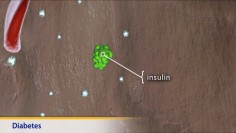
Diabetic Ketoacidosis in Children
What is diabetic ketoacidosis?
Diabetic ketoacidosis is a serious, life-threatening complication of lack of insulin. It may happen if your child has type 1 diabetes. (It rarely happens with type 2 diabetes.) It is an emergency that must be treated right away. If ketoacidosis is not treated right away, it can cause diabetic coma or death.
What is the cause?
Diabetic ketoacidosis happens when your child’s body does not have enough insulin. Without insulin, sugars in the blood cannot move out of the blood and into cells, and so the cells burn fats instead of sugar for energy. The burning of fats makes byproducts called ketones. The ketones build up to poisonous and dangerous levels in the blood. High blood sugar often happens at the same time as ketoacidosis because sugar also builds up in the blood.
When ketoacidosis happens, it means that your child’s diabetes is not in good control, or your child may be getting sick. Ketoacidosis may occur even with proper treatment for diabetes when there is a change in your child’s life such as:
- illness
- infection
- trauma
- surgery
- other types of physical or emotional stress
Sometimes the diagnosis of diabetes is not made until ketoacidosis occurs. When your child has type 1 diabetes, the pancreas stops making insulin. As a result, blood sugar may become very high, very fast. It may happen so fast that ketoacidosis symptoms are the first symptoms of diabetes.
What are the symptoms?
If your child has ketoacidosis, he or she may have these symptoms:
- excessive urination (several quarts a day)
- excessive thirstiness (several quarts a day)
- fruity-smelling breath
- rapid breathing
- nausea or vomiting
- confusion
- tiredness
Symptoms of high blood sugar include:
- increased thirst
- increased hunger
- dry mouth
- increased urination
- blurred vision.
The ketoacidosis symptoms leading to a diabetic coma usually happen gradually. In most cases it takes several hours to a couple of days for ketoacidosis to cause a diabetic coma.
How is it diagnosed?
A healthcare provider will review your child’s symptoms, ask about medical history, and examine your child. Your child provider will pay special attention to:
- possible infection
- the amount of fluids in your child body
- how clearly your child is thinking
- your child’s breathing
- how well your child’s heart and kidneys are working
Tests to check the levels of sugar and other chemicals in your child’s blood and urine diagnose diabetic ketoacidosis. If needed, your child may also have other lab tests, a chest X-ray, or ECG.
How is it treated?
Ketoacidosis needs to be treated right away. Your child needs to be treated at a hospital.
- Your child will be given insulin as soon as ketoacidosis is diagnosed.
- Your child’s blood will be checked often for sugar levels and chemical balances.
- Your child will be given intravenous (IV) fluids.
How can I prevent ketoacidosis?
To help take care of your child and prevent ketoacidosis, follow these guidelines:
- Learn as much as you can. Ask your healthcare provider to help you understand your child’s need for calories and insulin and how to be sure that he or she is getting the right amount of both.
- Make sure that your child eats a healthy diet.
- Follow the physical activity or exercise plan your child healthcare provider has recommended.
- Know the early signs and symptoms of ketoacidosis.
- Keep your child’s blood sugar level under control. Check your child’s blood sugar level as often as your healthcare provider directs. Make sure that your child never takes more insulin without checking the blood sugar reading and making sure the sugar level is too high. The symptoms of low blood sugar can be similar to those of high blood sugar.
- Test for ketones in your child’s urine if:
- Your child blood sugar level is higher than 240 mg/dL.
- Your child is ill or under more stress than usual.
- Check your child’s blood sugar more often if you think he or she is getting sick.
- Keep extra insulin on hand.
- Make sure your child carries an ID (such as a card or bracelet) that says that your child has diabetes, in case of an emergency.
When should I call my child's healthcare provider?
Call IMMEDIATELY if:
- Your child has type 1 diabetes and your child’s urine test for ketones is positive.
- Your child has fever or other symptoms of an infection, such as flu or a bladder infection.
- Your child has been vomiting and is unable to keep food and fluids down.
- Your child’s fasting blood sugar has been 240 mg/dL or more for 2 days, especially if you also have vomiting or other symptoms of ketoacidosis.
Call during office hours if:
- You have other questions or concerns.
Last modified: 2011-08-02
Last reviewed: 2010-11-29

